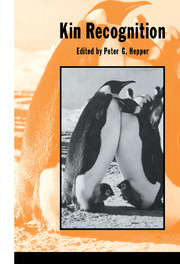Book contents
- Frontmatter
- Contents
- List of contributors
- Preface
- Introduction
- 1 The correlation between kinship and behaviour in non-human primates
- 2 Co-operation and reciprocity in birds and mammals
- 3 Kinship and fellowship in ants and social wasps
- 4 Successes and failures of parent–offspring recognition in animals
- 5 Kinship, kin discrimination and mate choice
- 6 Genetic components of kin recognition in mammals
- 7 Kin recognition in amphibians
- 8 Kin recognition cues of vertebrates
- 9 Recognizing kin: ontogeny and classification
- 10 Parental states as mechanisms for kinship recognition and deception about relatedness
- 11 Fetal learning: implications for the development of kin recognition
- 12 Information processing and storage during filial imprinting
- 13 The honey bee as a model kin recognition system
- 14 Mutual mother–infant recognition in humans
- Author index
- Species and common name index
- Subject index
3 - Kinship and fellowship in ants and social wasps
Published online by Cambridge University Press: 06 January 2010
- Frontmatter
- Contents
- List of contributors
- Preface
- Introduction
- 1 The correlation between kinship and behaviour in non-human primates
- 2 Co-operation and reciprocity in birds and mammals
- 3 Kinship and fellowship in ants and social wasps
- 4 Successes and failures of parent–offspring recognition in animals
- 5 Kinship, kin discrimination and mate choice
- 6 Genetic components of kin recognition in mammals
- 7 Kin recognition in amphibians
- 8 Kin recognition cues of vertebrates
- 9 Recognizing kin: ontogeny and classification
- 10 Parental states as mechanisms for kinship recognition and deception about relatedness
- 11 Fetal learning: implications for the development of kin recognition
- 12 Information processing and storage during filial imprinting
- 13 The honey bee as a model kin recognition system
- 14 Mutual mother–infant recognition in humans
- Author index
- Species and common name index
- Subject index
Summary
Introduction
The complex societies of wasps, ants and bees constitute a special problem for the Darwinian theory of evolution. This did not escape the attention of Charles Darwin. He considered these insects to represent ‘one special difficulty, which at first appeared to me insuperable, and actually fatal to my whole theory’ (The Origin of Species, Chap. VII, p. 236). If we accept that natural selection operates at the level of individual organisms, it is difficult to comprehend just how it could occur in species like those of eusocial insects, where the majority of individuals are almost always excluded from reproduction because of morphological specializations which generally involve sterility. Darwin conceived of an explanation which allowed him to reconcile the existence of insect societies with his theory of natural selection (‘This difficulty, though appearing insuperable, is lessened, or, as I believe, disappears, when it is remembered that selection may be applied to the family, as well as to the individual …’: ibid., p. 237). This interpretation led eventually to a significant step forward, when an analogy was drawn between the multicellular organism and the insect society, which was conceptualized as a ‘superorganism’ (Wheeler, 1911; Emerson, 1952). After being neglected for some years, this theory has recently been rehabilitated (Lumsden, 1982; Jaisson, 1985; Wilson, 1985). This mode of thinking helps to resolve the difficulties in understanding the functioning of natural selection in insect societies. It suggests that the social group, as a unit, can be influenced by selective pressures, and that there is a relationship between the reproductive caste and the sterile worker caste comparable to that between the soma and the germ plasm of a multicellular organism.
- Type
- Chapter
- Information
- Kin Recognition , pp. 60 - 93Publisher: Cambridge University PressPrint publication year: 1991
- 32
- Cited by



